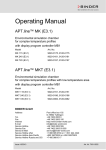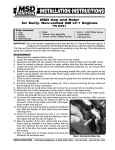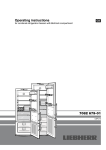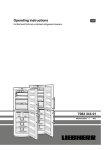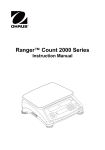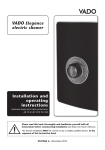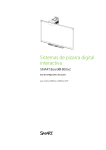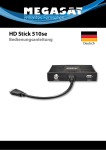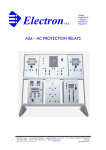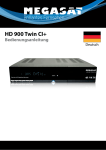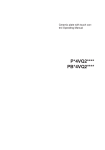Download Liebherr 7082 224-00 Refrigerator User Manual
Transcript
Operating instructions
for combined refrigerator-freezer with electronic control system, NoFrost
7082 224-00
CN/CNa...3
CN/CNa..3
1004
11
The appliance at a glance
Operating and control elements, fig. A1
Freezer compartment
1 Main On/Off control for the complete appliance (refrigerator and freezer compartment), with temperature control for
freezer compartment
2 SuperFrost button with indicator light for activated function
3 Temperature setting display for freezing temperature
4 Audible warning On/Off button, with indicator light for too
high temperature in freezer compartment
Refrigerator compartment
5 On/Off switch and temperature control for refrigerator
compartment
6 Temperature setting display for refrigerating temperature
Control setting for temperature
1st dot =
warm
max.
=
cold
W Recommended control setting for:
Refrigerator compartment: 5 °C, freezer compartment: -18 °C
SuperFrost
For fast freezing of fresh food.
W Press the SuperFrost button 2 briefly, so that it lights up.
W Wait approx. 6 - 24 hours.
W Place the fresh food in the drawers.
- The SuperFrost function switches off automatically after
about 65 hours.
Type/Data plate, fig. A2
1 Type designation
2 Service number
3 Appliance number
4 Freezing capacity in kg/24 hours
Description of appliance and equipment, fig. A
Refrigerator, approx. 5°C
Transport grips
Operating and control elements
Butter and cheese compartment
Fan with switch 7, for re-circulated air cooling
Egg tray*
Sectioned shelf for tall containers, adjustable* storage shelves
Adjustable bottle/can holder*
Adjustable door storage rack*
Interior light
Defrost drain (refrigerator)
Coldest area of the refrigerator compartment, suitable for coldsensitive and highly perishable foods
Bins for vegetables, salad and fruit
Type/Data plate
Door rack for large bottles and drinks
Freezer, approx. -18°C
Freezer tray*, cold-storage accumulator*, ice-cube tray*
VarioSpace
Information system*
Drawers with transparent front
Adjustable-height feet, transport grips, transport castors at back
12
* depending on model and options
CN/CNa..3
Congratulations on your purchase. In choosing this appliance you have opted for all the benefits
of state-of-the-art refrigeration technology, guaranteeing you top quality, a long life span and excellent
reliability.
The features on your appliance have been designed to ensure maximum convenience - day in, day out.
This appliance has been manufactured with recyclable materials using an environmentally friendly process,
so together you and we are making an active contribution to the preservation of our environment. To get to
know all the benefits of your new appliance, please read the information contained in these operating instructions carefully.
We wish you much pleasure with your new appliance.
Keep these operating instructions in a safe place and pass
them on to the next owner, where applicable.
The instruction is valid for several models, deviations are
therefore possible.
Contents
Operating instructions
Page
The appliance at a glance ................................ ......... 12
Contents ...................................................................... 13
Safety regulations ....................................................... 13
Notes on energy saving ............................................. 13
Safety instructions and warnings .................................... 14
Disposal notes ............................................................ 14
Setting up .................................................................... 14
Connecting to the mains ............................................ 14
Operation and control elements ...................................... 15
Switching the appliance on and off ............................ 15
Setting the temperature .............................................. 15
SuperFrost .................................................................. 15
Temperature setting display ....................................... 15
Audible warning signal, red visual warning light ........ 15
Refrigerating with fan .................................................. 15
Refrigerator compartment ................................................ 16
Arranging food in the refrigerator ............................... 16
Changing shelf arrangement ...................................... 16
Interior light ................................................................. 16
Freezer compartment ....................................................... 17
Freezing with SuperFrost ........................................... 17
Notes on freezing and storage ................................... 17
Information System .................................................... 18
Freezer tray ................................................................. 18
Cold-storage accumulators ........................................ 18
Making ice-cubes ........................................................ 18
Cleaning ............................................................................ 19
Troubleshooting ................................................................ 19
Customer service and type plate ............................... 19
Instructions for installation and modification
External dimensions of the appliance ....................... 20
Changing over door hinges ......................................... 20
Insertion into row of kitchen units .............................. 20
CN/CNa..3
Safety regulations
W The appliance is designed to cool, freeze and store food
and to make ice. It is designed as a household appliance.
Perfect functioning cannot be guaranteed for any other
use.
W The appliance is set to operate within specific ambient
temperature limits according to its climate rating. These
temperature limits should not be exceeded. The correct
climate rating for your appliance is indicated on the type
plate. This is explained as follows:
Climate class
SN
N
ST
T
designed for
ambient temperatures of
+10°C
+16°C
+18°C
+18°C
to
to
to
to
+32°C
+32°C
+38°C
+43°C
- The refrigerant circuit has been tested for leaks.
- The appliance complies with current safety regulations and
EC directives 73/23/EEC and 89/336/EEC.
Notes on energy saving
W Ensure that there is adequate space around the appliance
for ventilation and air extraction.
W Avoid keeping the door open for too long.
W Store food logically. Do not exceed the storage period
specified.
W Keep all food properly packed and covered so as to avoid
its frosting up on the outside.
W Always allow hot food to cool to room temperature before
placing in the appliance.
W Defrost frozen food in the refrigerator.
W Keep the appliance door shut in the event of a breakdown.
This will delay the cold loss The quality of the frozen goods
is maintained longer.
13
Safety instructions and warnings
Disposal notes
Setting up
The packaging is designed to protect the appliance
and individual components during transport and is
made of recyclable materials.
- Corrugated board/board
- Moulded polystyrene (foamed, CFC-free polystyrene)
- Polythene bags and sheets
- Polypropylene straps
W Keep packaging materials away from children polythene sheets and bags can suffocate!
W Please return the packaging material to your nearest
official collection point so that the various materials can be
reused or recycled as far as possible.
W When setting up/fitting ensure that the refrigerant circuit
pipes are not damaged.
W Standard EN 378 specifies that the room in which you
install your appliance must have a volume of 1 m3 per 8 g
of R 600a refrigerant used in the appliance, so as to avoid
the formation of inflammable gas/air mixtures in the room
where the appliance is located in the event of a leak in the
refrigerant circuit. The quantity of refrigerant is given on the
type plate in the interior of the appliance.
W Avoid positioning in direct sunlight or next to an oven, radiator or similar, in damp locations or near spraying water.
W Once in position, use the 10 spanner provided to
adjust the feet so that the appliance is level and
does not wobble.
W The ventilation grilles should not be obstructed.
Always ensure that there is good ventilation and
that the outward flowing air is able to escape.
More information can be found in the installation
and modification instructions.
W Do not place heat-emitting appliances, e.g. microwave oven, toaster, etc., on top of the refrigerator
or freezer.
W When you open the door for the first time, the handle
switches from the transport position to the operating
position; you will hear a soft click.
W Remove all transportation safety components:
- Remove sticky tape or spacers* from shelves and
insert shelves in the required position.
- Remove all protective film: from the decorative trims,
front walls and side walls*.
Your old appliance:
This contains some reusable materials and should not simply be
disposed of with household or bulk refuse.
W Disable discarded appliances immediately by removing the plug and cutting through the connection
cable.
Remove spring or bolt lock so that children cannot lock
themselves in when playing - they will suffocate.
W Ensure that the refrigerant circuit is not damaged before the
appliance that is no longer needed is taken away for disposal.
In this way the refrigerant or oil will not escape into the
environment.
- Exact details of the refrigerant used are given on the type
plate, heat insulator is PU with pentane.
- Information on collection dates or collection points can be
obtained from the waste disposal authorities or local
council.
Technical safety
W To prevent injury or damage to the unit, the appliance
should only be transported wrapped and set up by two
people.
W The refrigerant R 600a is environmentally friendly but flammable.
W Do not damage the refrigerant circuit pipes. Splashes of
refrigerant can harm your eyes or ignite.
W If refrigerant escapes, remove all naked flames or sources
of ignition in the vicinity of the leak, disconnect the appliance from the mains and ventilate the area well.
W In the event that the appliance is damaged, contact the
supplier immediately before connecting to the mains.
W To guarantee safe operation, ensure that the appliance is set up
and connected as described in these operating instructions.
W In the event of a fault, disconnect appliance from mains: pull out
the plug (do not pull on connection cable) or trip or turn out fuse.
W Any repairs and work on the appliance should only be
carried out by the customer service department, as
unauthorised work could prove highly dangerous for the
user. The same applies to changing the mains power cable.
Safety during use
W Do not store any explosive materials or spray cans
with flammable propellants in the appliance, such
as butane, propane, pentane etc. Electrical components
might cause leaking gas to ignite. You can identify such
sprays by the printed contents or a flame symbol.
W Only store high-percentage alcohol in tightly sealed,
upright containers.
W Do not allow naked flames or ignition sources to enter the
appliance.
W Do not use electrical appliances inside the appliance (e.g.
steam cleaners, heaters).
W Do not stand on the plinth, drawers or doors or use them to
support anything else.
W The appliance is not intended for use by young children or
infirm persons without supervision.
W Do not let children play with the appliance, e.g. do not allow them to sit in the drawers or swing on the door.
W Do not eat ice-cream, particularly ice lollies or ice-cubes, immediately after taking them from the freezer compartment as there is a
risk of "burning" because of the very cold temperatures.
W Do not consume food which has been stored for too long,
as it could cause food poisoning.
14
Connecting to the mains
Power supply (AC) and voltage
at the operating point must comply with the details on
the type plate, which is located inside the appliance
on the left, fig. A.
W Connect the appliance with a properly earthed fused
plug and socket only.
W The socket must be fused with a 10 A fuse or higher, it must
be away from the rear of the appliance and must be easily
accessible.
W Do not
- connect to stand-alone inverters,
- operate with so-called energy-saving plugs - this can damage the electronic system,
- connect to the supply with other equipment using an
extension cable - risk of overheating.
W When removing the mains cable from the back of the appliance, remove the cable holder so as to avoid vibration
noise.
The wires in the mains lead are coloured in accordance with
the following code:
green/yellow = earth, blue = neutral, brown = live.
Warning! This appliance must be earthed.
Non-rewireable plugs BS 1363
If this machine or appliance is fitted with a non-rewireable
plug, the following information applies: If the socket outlets are
not suitable for the plug supplied with this product, it must be
cut off and an appropriate plug fitted. The plug cut from the
flexible cord should be disposed of and on no account be
inserted into a 13 A socket elsewhere in the house (electric
shock hazard).
The fuse cover must be re-fitted when changing the fuse,
and if the fuse cover is lost the plug must not be used until a
suitable replacement is obtained. The colour of the correct
replacement cover is that of the coloured insert in the base of
the plug, or the colour that is embossed in words on the base
of the plug (as applicable to the design of the plug fitted).
The correct rating of the replacement fuses that are ASTA approved to BS 1362 should be fitted. Replacement fuse covers
may be purchased from your local electrical suppliers,
electricity showroom or approved service agent.
CN/CNa..3
Operation and control elements
SuperFrost 2
Fresh food should be frozen to the core as rapidly as possible.
Frozen food can also be given a cold boost. This ensures that
the nutritional value, appearance and flavour of the food
remain intact.
W The maximum amount of food which can be frozen in
24 hours is shown on the type plate ("Freezing capacity
... kg/24h"). This amount varies according to the model
and climate rating.
See section "Freezing with SuperFrost" for more information.
You are advised to clean the appliance before switching it on
for the first time (see "Cleaning").
Switch on the appliance approx. 4 hours before loading it with
frozen food for the first time. Do not load with frozen food until
the red warning light has gone out.
Switching the appliance on and off
- Fig. A1: With the main On/Off control 1 you always
switch the complete appliance on or off, freezer and
refrigerator compartment.
W Switching on: Turn the slot of the temperature control 1
for the freezer compartment and 5 for the refrigerator
compartment with a coin, so that the temperature setting
displays 3 and 6 flash/light up.
- The refrigerator compartment is switched on when the temperature setting display 6 is lit and the interior light is on.
- The freezer compartment is switched on when the temperature setting display 3 is lit.
- The alarm button lights up red until the freezing temperature is
low enough; it will then go out. See section "Audible warning
signal, red visual warning light" for more information.
W Switching off the complete appliance: Turn the slot of the
main On/Off control 1 with a coin right back to position "0",
so that the temperature setting displays are unlit. The refrigerator and freezer compartments are switched off.
W If you want to switch off only the refrigerator compartment
(freezer compartment remains switched on - advantageous,
for example, for holiday periods), turn only the On/Off
control 5 back to "0", so that the temperature setting
display of the fridge compartment 6 and the interior light
are unlit. The temperature setting display of the freezer
compartment 3 must be lit.
Setting the temperature
W Turn temperature controls 1 and 5 with a coin until the
displays 3 and 6 of the required temperatures are lit.
The slot positions mean:
1st dot
max.
= highest temperature,
lowest refrigerating capacity
= lowest temperature,
highest refrigerating capacity
W Recommended temperature setting:
- For the refrigerator compartment: 5 °C
- For the freezer compartment: -18 °C
During setting, the display of the set temperature flashes.
Note: Please note that the temperature inside the appliance
is affected by the frequency with which the door is opened,
how full the appliance is and the room temperature at the
place where the appliance is installed.
The control is to be readjusted according to the temperature
required.
Temperature setting display
3 for freezer compartment
6 for refrigerator compartment
- The lit temperature setting display indicates operation of
the appliance.
- Temperature ranges are allocated to the individual displays.
They indicate the selected setting of the refrigerating/freezing
temperature.
Audible warning signal,
red visual warning light
The audible warning signal and the red visual warning light
help you to protect the frozen food and to save energy.
W The buzzer is switched off by pressing the audible warning
on/off button 4,
- or automatically when the sufficiently low storage temperature has been reached again.
- It lights up when the freezer temperature is not low enough
(dependent on the temperature setting).
- At the same time the red lamp of the audible warning on/off
button flashes.
This can be caused by
- warm, fresh food being placed in the freezer,
- too much warm air entering the freezer when you repack it
or take out frozen food. This temperature fluctuation has no
effect on the frozen food.
- When the audible warning on/off button is pressed, the red
visual warning light switches over from flashing mode to
permanently lit. It only goes out when the alarm state is
ended and a sufficiently low temperature has been reached. The audible warning signal is now automatically
reset.
W In case the SuperFrost button flashes simultaneously with
a light in the temperature display, there may be a fault.
Please contact your customer service centre and inform
them of the flashing lights. This will ensure that your
appliance can be serviced promptly and accurately.
Refrigerating with fan*
for re-circulated air cooling
This achieves a relatively even temperature distribution over
all storage levels; all foods are equally cool, at an adjustable
temperature. With enforced air circulation, the different
temperature ranges prevalent during normal operation no
longer exist.
It is generally recommended:
- with high room temperatures (above
approx. 30 °C),
- with high humidity, e.g. on summer days.
W Switching on/off: Press fan switch 7.
= on, 0 = off.
Note:
- When the fan is switched on, power consumption is
increased.
- To save energy, the fan switches off automatically when
the door is open.
CN/CNa..3
* depending on model and options
15
Refrigerator compartment
Arranging food in the refrigerator
1
2
3
4
5
6
7
butter, cheese
eggs
cans, drinks, bottles
preserves
dairy products, baked goods
meat and sausage products, fish, pre-cooked meals
fruit, vegetables, salad
Because of the natural circulation of air in the refrigerator compartment, the temperature in different parts of the refrigerator
will differ, each area being suitable for different types of food.
The coldest temperature is immediately above the vegetable
bins and on the rear wall (useful, for example, for sausages
and meats); the warmest temperature is at the top front area
and in the door (useful, for example, for spreadable butter
and cheese).
See fig. B for food storage suggestions.
Notes on cooling
- Store food in such a way that the air can circulate well, i.e.
do not store goods too close together.
- Food which gives off or absorbs odours and flavours, and
liquids should always be stored covered or in closed
containers.
- Always store food which gives off or is sensitive to ethylene
gases such as fruit, vegetables and salads separately or
wrapped in order not to affect their storage life; e.g. do not
store tomatoes together with kiwis or cabbage.
Changing shelf arrangement
You can re-arrange the height of the shelves and door racks
as required.
W Re-positioning the door racks, fig. C: Slide the door rack
up, pull out towards you and replace in reverse order.
W By adjusting the bottle holder you can prevent bottles
from tipping when the door is opened and closed.
W Re-positioning the shelves, fig. D:
- Lift the shelf, slide forwards and remove.
Always insert shelves with the guard bar at the back
pointing upwards, otherwise food may freeze onto the rear
wall.
- The glass shelves are fitted with stops to prevent them
being pulled out accidentally.
W If you require space for large bottles and containers
- Lift the front half glass shelf* slightly and carefully slide
under the rear shelf until the pull-out stops lock into position
in the recesses, fig. E.
Interior light
This switches off automatically after the door has been
opened for approx. 15 minutes. If it does not switch on when
the door is opened briefly, but the temperature display is
working, the bulb may be defective.
Replacing the bulb:
W Bulb data: max. 25 W; current and voltage must agree
with the details on the type plate. Only use bulbs of the
same size. Bulb fitting: E 14.
W Switch off the appliance. Disconnect from the mains or
remove or unscrew the fuse.
W Push the sides of the lamp cover fig. F1 together 1,
disengage and unhook from rear 2.
W Replace the bulb as in fig. F2.
W Clip the back end of the cover in and clip the sides into
place.
16
* depending on model and options
CN/CNa..3
Freezer compartment
Freezing with SuperFrost
W Press SuperFrost button 2 briefly, so that it is lit.
The freezer temperature will decrease and the
appliance will switch to the lowest temperature.
W With a small quantity of food to be frozen, wait for
approx. 6 hours - normally sufficient, for maximum quantity
see type plate under freezing capacity, approx. 24 hours.
W Then place the fresh food inside the freezer, preferably in
the top drawers.
If freezing the maximum quantity of food, do not use the
drawers; instead, place the wrapped food directly on the
cooling plates. Once the food is frozen you can load it into
the drawers.
- The SuperFrost function switches off automatically after
about 65 hours. The freezing process is now complete, the
SuperFrost button will go dark, and the freezer will switch
back to normal energy-saving operation.
W Storage: Each drawer and cooling plate can take up to
25 kg frozen food.
W VarioSpace: By removing the 2nd and 3rd drawer and the
storage tray, you obtain the storage space for bulky goods
equivalent to two drawer heights. Poultry, meat, large
game pieces and tall baked goods can be frozen whole
and further prepared in one piece.
W If you want to use the maximum net capacity, you can remove
the drawers and store items directly on the shelves.
- Always leave the bottom drawer in the appliance.
- If you have removed the top drawer, do not cover the fan slits
at the back, otherwise the freezer will not work properly.
Note: You should not switch on the SuperFrost function:
- when placing frozen food in the freezer;
- when freezing up to approx. 2 kg fresh food daily.
Notes on freezing and storage
W Items suitable for freezing: meat, game, poultry, fresh fish,
vegetables, fruit, dairy products, bread, baked goods, precooked meals.
Not suitable: lettuce, radishes, grapes, whole apples and
pears, fatty meat.
W Pack frozen food in standard freezer bags or re-usable
plastic, metal or aluminium containers.
W Do not allow fresh food which is to be frozen to come into
contact with food already frozen. Always keep packs dry in
order to avoid them sticking together.
W Always write the date and contents on the pack and do not
exceed the stated storage time for the food. This prevents
any risk of quality impairment.
W Pack food which you are freezing yourself in quantities
appropriate to your household. To ensure that the food
freezes right through quickly, the following quantities
should not be exceeded per package:
- fruit, vegetables: up to 1 kg;
- meat: up to 2.5 kg.
W Blanch vegetables after washing and cutting them. (Add
to boiling water for 2-3 minutes, remove and quickly cool
down in cold water. If you blanch with a steamer or microwave oven, please observe the relevant operating instructions.)
W Do not salt or season fresh food or blanched vegetables
before freezing. Only lightly salt and season other food.
Some spices can alter their flavour intensity.
W Do not freeze bottles and cans with carbonated drinks.
They may burst. Drinks can be cooled down quickly, but
take the bottles out of the freezer compartment after an
hour at the most.
CN/CNa..3
- Removing drawers, fig. G1: Pull forward until the drawer
stops and lift out.
- Removing the shelf, fig. G2: Remove the drawers directly
above and below the shelf. Press the hook at the back
underneath the shelf downwards and pull the shelf out
towards you.
To insert: slide shelf in and allow to click into place.
W Always store identical food items together to avoid the door
being open for unnecessarily long periods and to save
energy.
W Do not exceed storage times given.
W Thawing: Only take out as much food as is immediately
required for thawing. Cook food which has been thawed as
quickly as possible.
Frozen food can be thawed in the following ways:
- in a conventional or fan oven
- in a microwave oven
- at room temperature
- in the refrigerator: the cold given off by the frozen food is
used for cooling the other food.
- Flat portions of meat or fish can be cooked when partially
thawed.
- Vegetables can be cooked from frozen (in half the normal
time).
17
Freezer compartment
Information system*
pre-cooked meals
ice-cream
fish
pork
vegetables
fruit
sausages
bread
mushrooms
game
poultry
Use frozen food within the recommended period.
The numbers between the symbols indicate the storage period in
months for different kinds of frozen foods.
Storage times given are guide times for food frozen at home.
Whether or not the lower or upper value is applicable depends
on the food quality and how it was processed prior to freezing.
The lower values always apply to food with a high fat content.
beef/veal
Freezer tray*
allows individual freezing of berries, herbs, vegetables and
other small frozen goods. It prevents foods freezing together.
Items being frozen will largely retain their shape, and it will be
easier to remove exactly the right quantity later on.
W Spread the items out loosely on the tray, fig. H.
W Suspend the freezer tray in one of the top drawers. Freeze for
10 to 12 hours, then transfer to a freezer bag or container
and put in a drawer.
W To defrost, spread the frozen items out loosely.
Cold-storage accumulators*
These prevent the temperature in the freezer from rising too
quickly in the event of a power failure, thus preserving the
quality of the food.
W To save space, you can freeze and store the cold-storage
accumulators in the freezer tray, fig. J.
- To ensure maximum storage time in the event of a power
failure, place the frozen cold-storage accumulators in the
top freezer drawer on top of the food.
Making ice-cubes*
W Press the locking bolt downwards.
W Fill the ice-cube tray with water. Surplus water will flow through
the drain hole.
W Push the locking bolt upwards.
W Place the ice-cube tray in the appliance and leave it to freeze.
W The ice-cubes can be removed from the tray by twisting or by
holding upside down for a short time under running water.
18
* depending on model and options
CN/CNa..3
Cleaning
Troubleshooting
Note on defrosting
The defrost water is evaporated by the heat from the compressor; drops of water on the rear wall are perfectly normal.
W Ensure that the defrost water can flow freely through the
drain hole in the rear wall (arrow in fig.).
Your appliance is designed and manufactured for a long life
span and reliable operation.
If a malfunction nonetheless occurs during operation, check
whether it is due to an operating error. Please note that even
during the warranty period the resultant servicing costs in this
case will have to be borne by the owner.
You may be able to rectify the following faults by checking the
possible causes yourself:
In the freezer compartment
Malfunction
The NoFrost system defrosts the appliance automatically.
In the refrigerator compartment
The moisture produced accumulates on the evaporator, is
periodically defrosted and evaporates.
Due to the automatic defrosting principle, the freezing compartment remains free of ice at all times, no work or time is
required for manual defrosting.
Cleaning
W Before cleaning, always switch off the appliance.
Disconnect from the mains or unscrew or remove
the fuse.
W Clean the outer walls, inside and equipment by
hand with lukewarm water and a little detergent. Because
of the risk of injury and damage to the appliance, steam
cleaning equipment should not be used.
W We recommend using a soft cloth and an all-purpose cleaner with a neutral pH value. Only use food-safe cleaning
and care products in the interior of the appliance.
- Do not use scouring/abrasive sponges, concentrated
cleaning agents and cleaning or chemical solutions
containing sand, chloride or acids; they damage the
surfaces and can cause corrosion.
- Do not allow cleaning water to run down the drain gulley or
to penetrate the ventilation grilles or electrical components.
Dry the appliance.
- Do not damage or remove the type plate on the inside of the
appliance - it is important for the customer service department.
W Clean the drain hole on the rear wall
above the vegetable bins frequently,
see arrow in figure.
If necessary, clean with a thin object, e.g. a cotton swab or similar.
W The dust should be removed from the
refrigeration unit and heat exchanger metal grid at the back of the appliance
- once a year. Dust deposits increase
energy consumption.
W Ensure that none of the wires or other
components are dislodged, bent or
damaged.
W Then connect/switch on the appliance,
and switch on SuperFrost. You can start loading the freezer
as soon as the red visual warning light has gone out.
If the appliance is to be left switched off for any length of
time, empty the appliance, disconnect from the mains, clean
as described above and leave the door open so as to avoid
odours.
CN/CNa..3
Possible cause and remedy
Appliance does not work, display is unlit
- Is the appliance switched on properly?
- Is the mains plug properly inserted in the socket?
- Is the socket fuse intact?
The interior light does not come on
- Is the refrigerator compartment switched on?
- Has the door been open for more than 15 minutes?
- The bulb is defective. Change the bulb as described in
"Interior light".
Loud running noise
- Is the appliance standing firmly on the floor, or does the
compressor cause nearby items of furniture or objects to
vibrate? If necessary, move the appliance slightly, align by
adjusting the adjustable feet, or move bottles and containers
apart.
- The following are normal: flow noises, bubbling or dripping
noises, they come from the refrigerant flowing in the
refrigerant circuit.
A short clicking sound: This will be heard whenever the
refrigeration unit (the motor) switches on or off automatically.
Motor noise: This will be slightly louder for a brief period
when the refrigeration unit switches on.
Alarm sounds, red visual warning light button lights up,
temperature is not low enough
- Have you put too much fresh food into the freezer without
activating SuperFrost? (See section "SuperFrost")
- Does the door close properly?
- Is the appliance sufficiently well ventilated?
Clear ventilation grilles if necessary.
- Is the ambient temperature too hot?
(See section "Safety regulations")
- Has the appliance been opened too often or left open too
long?
Customer service and type plate
If none of the above causes apply and you cannot rectify
the fault yourself, or if more than one indicator light is
flashing, please contact your nearest service centre
(see attached list).
Inform the service centre of the
type designation 1,
service number 2 and
appliance number 3
of the type plate, and which of the
indicator lights are flashing, so as
to ensure rapid, specific service.
The type plate is located inside the
freezer compartment on the left-hand
side.
Leave the appliance shut until the customer service engineer
arrives so as to prevent any further cold loss.
* depending on model and options
19
Instructions for installation and modification
For the external dimensions of the appliance, see fig. S
attached to the rear of the appliance and the table below.
Appliance, gross capacity of models (l)
see type plate
289
337
375
383
(30..)
(35..)
(39..)
(40..)
Height H
(mm)
1625
1806
2000
1982
Installation instructions
Do not install the appliance side-by-side with another refrigerator or freezer. This is important to prevent condensation and
consequential damage from it.
Changing over door hinges
- Suspend lower door, close.
- Rotate hinge component 4by 180°, remove hinge pin 5,
turn by 180° and replace. Mount both parts in the hinge bq:
slide the pin into the door mounting through the hinge, tilt
in the hinge component, slide up and attach with screw 3.
W Align the door flush with the body of the appliance using
the slot on the hinge bq, then tighten screw 3.
W Attach the plinth panel 1and click into place by pressing.
W With the door open, insert the cover 2 in the plinth panel
at the front and click into place at the back.
W Transfer* door handles br and plugs bt. With the door
open, carefully lift out the pressure plates* bs at the front
and slide away; unscrew handle using a Torx® or Phillips
screwdriver*.
Reassemble in reverse order: replace the pressure plates
and click into position.
Fig. T. The door hinges can be changed from one side to the
other if required:
Insertion into row of kitchen units
Only change over door hinges when mains plug is disconFig. U. The appliance can be integrated into the kitchen units.
nected!
To adapt the appliance to the height of the row of kitchen
W With the door open, lever out plinth panel 1 on the hinge
units, a suitable top cupboard can be fitted above the
side with a screwdriver and remove from front.
appliance 1.
- Lever out cover 2 with a screwdriver. Close door.
For ventilation and air extraction, an exhaust air shaft at least
- Unscrew screw M5 3.
50 mm deep must be provided on the rear of the top cupboard
W Pull hinge component 4 with hinge pin 5 out from underover the entire width of the cupboard. The ventilation crossneath and remove.
section below the ceiling of the room should be at least 300 cm2.
- Open door, lift out at bottom and remove.
Generally, the bigger the cross section, the more economically
- Pull middle hinge pin 6out from underneath.
the appliance operates.
- Tilt out top door and lift off from underneath (with version I,
W When integrating with standard kitchen units (depth max.
do not lose spacer sleeve 9).
580 mm) and decor panels of up to max. 2 mm thick, the
W Transfer all hinge components onto the other side:
appliance can be installed directly next to the kitchen unit.
W Top: depending on version, proceed as follows:
The door of the appliance protrudes beyond the front of the
Version I (visible operating panel): Lever out covers 8with a
kitchen unit 34 mm at the side and 51 mm in the centre of
screwdriver at the front and remove at an angle from below.
the appliance. This allows it to be opened and closed
Remove hinge pin 7 and insert on the opposite side. Use
easily.
the hexagon socket on the open-ended spanner provided
W When installing the appliance next to a wall 4, a distance
(spanner width 5). Fit covers 8 again: insert at rear and click
on the hinge side of min. 36 mm is required between the
into place at front.
appliance and the wall (handle projection with door open).
Version II (concealed operating panel): Lift up cover 8 on
1Top cupboard
3 Wall of kitchen units
handle side, push outwards; lift up cover on hinge side and
2
Refrigerator/freezer
4 Wall
pull off.
- Unscrew earthing plate cm: first earthing screw cl, then inner
retaining screw cq.
Note on fitting decor panel*
- Unscrew hinge 9: first undo earthing screw cl, then retai(with white appliances of height H = 1806 and 1982 mm)
ning screws cq. Fit hinge 9to opposite side: for easy assemWith decor panel and decor frame, you can adapt the applibly, fit hinge from above and first tighten with the upper retaiance to the front of the kitchen units or contrast with them.
ning screw cq M5, then screw cq and finally earthing screw
The decor panels can be obtained from your kitchen furniture
cl M4.
supplier. The decor frames can be retrofitted from your kitchen
- Turn earthing plate cm through 180° and screw tight again
furniture supplier.
on the new handle side: first retaining screw cq, then earthing
If you wish to fit the decor panel yourself, you require a drill or
screw cl.
cordless screwdriver to pre-drill the retaining holes. The door
- Insert hinge pin 7 in the other retaining hole. Use the
handles are to be replaced by the rigid handles included in
hexagon socket on the open-ended spanner provided
the decor frame retrofit set. For further assembly instructions
(spanner width 5).
and dimensions, please see the assembly instructions
- Fit covers 8 again: insert hinge-side cover by sliding outincluded in the retrofit set.
wards and click into position; insert handle-side cover by
sliding inwards and click into position.
W Centre: Change over cover bl with hinge bm: unscrew screws,
lift off cover bl and hinge bm to the side, turn through 180°
and replace on the other side, remove hinge bushing bn and
re-insert from top.
- Bottom: Using a screwdriver, remove the spacer bo, fig. T1,
and replace on the other side.
W Re-attach the doors:
- Remove plugs bp from the door mounting points and re___________________________________________________
place on the other side.
- Suspend top door in hinge pin 7(with version I, do not
The manufacturer is continually working on the continous
lose spacer sleeve 9), close door.
improvement of all types and models. We therefore hope for
- Slide middle hinge pin 6 into the door mounting from
your understanding that we reserve the right to alter design,
below through the hinge bm. Make sure the door is flush
equipment and technology without notice.
with the body of the appliance; adjust if necessary using
the slots on the hinge.
* depending on model and options
20
CN/CNa..3
CN/CNa..3
21











